The global base editing market is projected to grow from USD 258.9 million in 2025 to approximately USD 915.4 million by 2035, recording an absolute increase of USD 656.5 million over the forecast period. This translates into a total growth of 253.6%, with the market forecast to expand at a compound annual growth rate (CAGR) of 13.5% between 2025 and 2035. The overall market size is expected to grow by nearly 3.54X during the same period, supported by increasing adoption of gene editing technologies, rising investment in precision medicine, and growing applications in drug discovery and agricultural biotechnology.
Between 2025 and 2030, the base editing market is projected to expand from USD 258.9 million to USD 488.2 million, resulting in a value increase of USD 229.3 million, which represents 34.9% of the total forecast growth for the decade. This phase of growth will be shaped by advancing CRISPR technologies, increasing pharmaceutical industry adoption, and growing research funding for genetic medicine applications. Biotechnology companies are expanding their base editing capabilities to address the growing demand for precise genetic modification tools in therapeutic development.
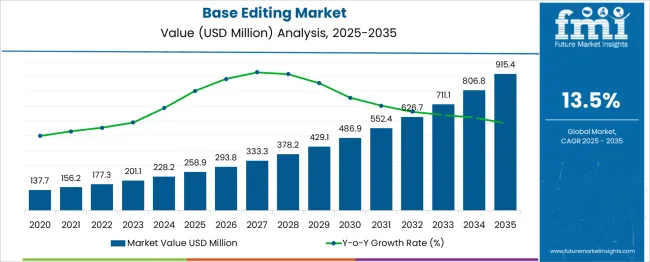
| Metric | Value |
| Estimated Value in (2025E) | USD 258.9 million |
| Forecast Value in (2035F) | USD 915.4 million |
| Forecast CAGR (2025 to 2035) | 13.5% |
From 2030 to 2035, the market is forecast to grow from USD 488.2 million to USD 915.4 million, adding another USD 427.2 million, which constitutes 65.1% of the overall ten-year expansion. This period is expected to be characterized by clinical translation of base editing therapies, expansion of agricultural applications, and development of next-generation editing platforms. The growing adoption of personalized medicine approaches and regulatory approvals for gene-edited therapies will drive demand for advanced base editing technologies with enhanced precision and safety profiles.
Between 2020 and 2025, the base editing market experienced robust expansion, driven by breakthrough developments in CRISPR technology and increasing recognition of base editing's advantages over traditional gene editing approaches. The market developed as pharmaceutical companies and research institutions recognized the potential for treating genetic diseases through precise nucleotide modifications. Scientific publications and successful preclinical studies began demonstrating the therapeutic potential of base editing for addressing previously intractable genetic disorders.
Market expansion is being supported by the increasing prevalence of genetic disorders and the corresponding demand for precise therapeutic interventions. Modern healthcare systems are increasingly focused on personalized medicine approaches that can address the root causes of genetic diseases through targeted DNA and RNA modifications. Base editing's ability to make precise single nucleotide changes without creating double-strand breaks makes it a preferred technology for developing safer and more effective gene therapies.
The growing investment in biotechnology research and development is driving demand for advanced gene editing tools that offer greater precision and fewer off-target effects. Pharmaceutical companies' interest in developing base editing therapies for rare diseases and cancer is creating opportunities for technology platforms and service providers. The rising collaboration between academic institutions and industry partners is also contributing to rapid technological advancement and commercialization of base editing applications across therapeutic areas.
The market is segmented by products & services outlook, application outlook, type outlook, end use outlook, and region. By products & services outlook, the market is divided into product (platform, kits & reagents, plasmids, base editing libraries) and services (gRNA design, cell line engineering). Based on application outlook, the market is categorized into drug discovery & development, agriculture, veterinary, and others. In terms of type outlook, the market is segmented into DNA base editing and RNA base editing. By end use outlook, the market is classified into pharmaceutical & biotechnology companies, academic & research institutes, and contract research organizations. Regionally, the market is divided into North America, Europe, East Asia, South Asia & Pacific, Latin America, and Middle East & Africa.

The product segment is projected to account for 60% of the base editing market in 2025, reaffirming its position as the category's primary revenue generator. Organizations increasingly require comprehensive base editing platforms, specialized reagents, and validated plasmid libraries to conduct precise genetic modifications. The demand for ready-to-use base editing tools that can streamline research workflows and reduce development timelines continues to drive product adoption across pharmaceutical and academic settings.
This segment forms the foundation of base editing capabilities, as it provides the essential tools and technologies required for successful gene modification experiments. Continuous innovation in base editor design and delivery systems strengthens the value proposition of product offerings. With research institutions and biotechnology companies expanding their gene editing programs, product demand aligns with both discovery research and therapeutic development objectives. Its broad utility across multiple applications ensures sustained dominance, making it the central growth driver of base editing market expansion.

Drug discovery & development is projected to represent 52% of base editing market demand in 2025, underscoring its role as the primary application driving technology adoption. Pharmaceutical companies gravitate toward base editing for its ability to create precise disease models, validate drug targets, and develop novel therapeutic candidates. Positioned as a transformative tool for precision medicine, base editing offers both target identification capabilities and direct therapeutic applications for genetic diseases.
The segment is supported by increasing investment in gene therapy programs and the growing pipeline of base editing therapies entering clinical trials. Additionally, pharmaceutical companies are increasingly integrating base editing into their drug discovery workflows to accelerate target validation and lead optimization processes. As the industry prioritizes precision medicine approaches and seeks to address previously undruggable targets, base editing applications in drug discovery and development will continue to dominate market demand, reinforcing their critical role within the biotechnology ecosystem.
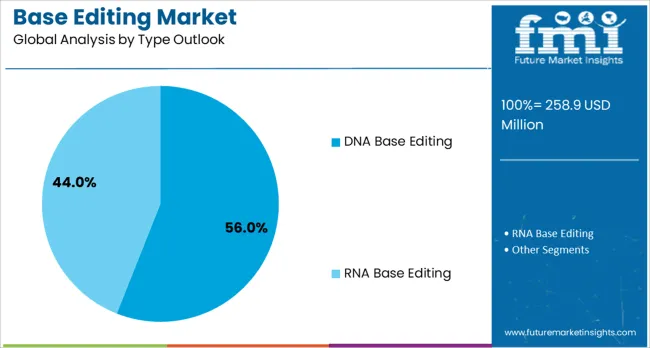
DNA base editing is forecasted to contribute 56% of the base editing market in 2025, reflecting its established position as the most mature and widely adopted editing approach. Researchers and therapeutic developers prefer DNA base editing for its ability to make permanent genetic modifications that can correct disease-causing mutations at their source. This technology's proven track record in preclinical studies and emerging clinical applications provides confidence in its therapeutic potential.
The segment benefits from continuous technological improvements in base editor variants, delivery methods, and targeting strategies that enhance editing efficiency and reduce off-target effects. DNA base editing's applicability across diverse cell types and organisms makes it valuable for both research and therapeutic applications. With multiple DNA base editing therapies advancing through clinical development and demonstrating promising safety profiles, this technology serves as a cornerstone for genetic medicine advancement, driving sustained market growth and innovation.
The base editing market is advancing rapidly due to increasing investment in gene therapy research and growing demand for precise genetic modification tools. However, the market faces challenges including technical complexity, regulatory uncertainties, and high development costs associated with clinical translation. Innovation in base editor design and delivery systems continues to influence technology adoption and therapeutic development patterns.
The growing number of base editing therapies entering clinical trials is validating the technology's therapeutic potential and attracting increased investment. Success in early-stage clinical studies is building confidence among pharmaceutical companies and investors regarding base editing's ability to address genetic diseases. The expansion of therapeutic applications beyond rare diseases to include oncology and common genetic disorders is broadening market opportunities.
Modern base editing developers are incorporating artificial intelligence and machine learning algorithms to optimize editor design and predict editing outcomes. These computational approaches improve targeting specificity, reduce off-target effects, and accelerate the development of novel base editor variants. Advanced modeling techniques also enable better understanding of editing mechanisms and facilitate rational design of improved editing tools.
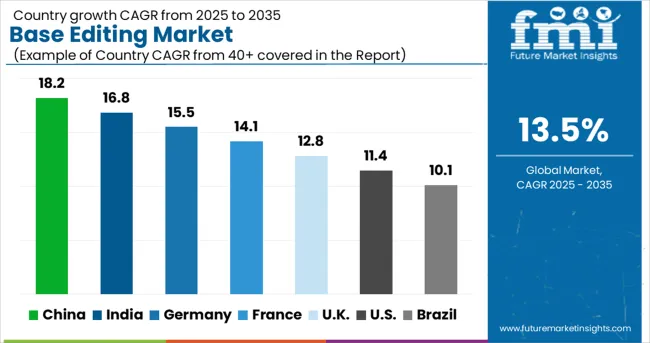
| Country | CAGR (2025-2035) |
| China | 18.2% |
| India | 16.8% |
| Germany | 15.5% |
| France | 14.1% |
| UK | 12.8% |
| USA | 11.4% |
| Brazil | 10.1% |
The base editing market is experiencing robust growth globally, with China leading at an 18.2% CAGR through 2035, driven by substantial government investment in biotechnology, expanding research infrastructure, and growing focus on precision medicine development. India follows at 16.8%, supported by increasing biotechnology sector growth, rising research funding, and expanding pharmaceutical industry adoption. Germany shows strong growth at 15.5%, emphasizing technological innovation and clinical translation. France records 14.1%, focusing on academic research excellence and biotechnology commercialization. The UK demonstrates 12.8% growth, prioritizing gene therapy development and regulatory framework advancement. The report covers an in-depth analysis of 40+ countries; seven top-performing countries are highlighted below.
Revenue from base editing in China is projected to exhibit strong growth with a CAGR of 18.2% through 2035, driven by massive government investment in genetic research and biotechnology infrastructure development. The country's strategic focus on becoming a global leader in precision medicine is creating significant demand for advanced gene editing technologies. Major research institutions and emerging biotechnology companies are establishing comprehensive base editing programs to advance both therapeutic development and agricultural applications.
Revenue from base editing in India is expanding at a CAGR of 16.8%, supported by increasing investment in biotechnology research, growing pharmaceutical industry capabilities, and rising focus on addressing genetic diseases prevalent in the population. The country's large patient population and diverse genetic landscape are driving demand for precision medicine approaches using base editing technologies. Both domestic and international companies are establishing research facilities to leverage India's scientific talent and cost advantages.

Demand for base editing in the USA is projected to grow at a CAGR of 11.4%, supported by strong venture capital investment, advanced research infrastructure, and favorable regulatory environment for gene therapy development. American companies are leading clinical translation of base editing therapies with multiple programs in human trials. The market is characterized by strong collaboration between academic institutions, biotechnology companies, and pharmaceutical partners.
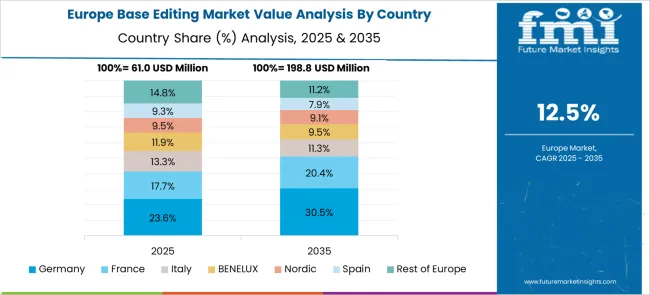
The base editing market in Europe demonstrates strong research capabilities across major economies with Germany showing robust presence through its advanced biotechnology sector and well-funded research institutions, supported by government initiatives promoting genetic medicine development and strong collaboration between academia and industry partners developing innovative base editing platforms for therapeutic applications. France represents a significant market driven by its excellence in molecular biology research and growing investment in precision medicine, with academic institutions and biotechnology companies pioneering novel base editing approaches for treating genetic disorders and advancing agricultural biotechnology applications.
The UK exhibits considerable growth through its world-class research universities and supportive regulatory environment for gene therapy development, with institutions like the Wellcome Sanger Institute and companies advancing base editing technologies for clinical translation and commercial applications. Italy and Spain show expanding capabilities in base editing research, particularly in developing therapeutic applications for rare genetic diseases and agricultural improvements. BENELUX countries contribute through their focus on collaborative research networks and specialized biotechnology clusters, while Eastern Europe and Nordic regions display growing potential driven by increasing research funding and expanding biotechnology infrastructure supporting base editing technology adoption across diverse application areas.
Revenue from base editing in Germany is projected to grow at a CAGR of 15.5% through 2035, driven by the country's strong research ecosystem, well-funded academic institutions, and growing biotechnology industry focus on precision medicine. German researchers consistently contribute significant innovations in base editing technology development and therapeutic applications.
Revenue from base editing in the UK is projected to grow at a CAGR of 12.8% through 2035, supported by world-class research institutions, progressive regulatory framework, and strong venture capital ecosystem for biotechnology companies. British researchers and companies are advancing base editing applications across therapeutic and agricultural sectors.
Revenue from base editing in France is projected to grow at a CAGR of 14.1% through 2035, supported by the country's excellence in molecular biology research, strong academic-industry partnerships, and government support for biotechnology innovation. French institutions are contributing significant advances in base editing technology and therapeutic applications.
Revenue from base editing in Brazil is projected to grow at a CAGR of 10.1% through 2035, supported by increasing government investment in biotechnology, expanding research capabilities, and growing focus on addressing regional health challenges through genetic medicine. Brazilian institutions are developing base editing applications for both therapeutic and agricultural purposes.
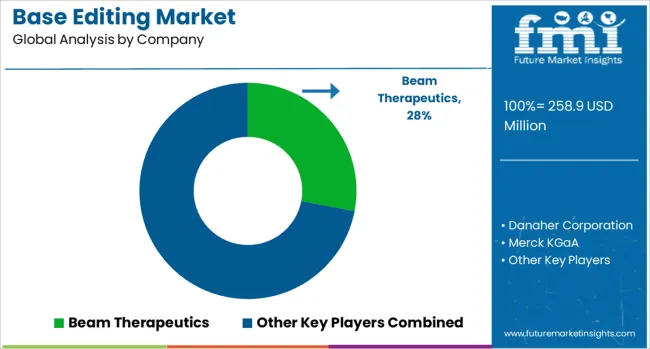
The base editing market is characterized by competition among specialized biotechnology companies, established pharmaceutical firms, and technology platform providers. Companies are investing in proprietary base editor development, delivery system optimization, intellectual property portfolios, and strategic partnerships to deliver effective, scalable, and commercially viable base editing solutions. Technology innovation, clinical development progress, and market access strategies are central to strengthening competitive positioning and market leadership.
Beam Therapeutics, USA-based, leads the market with 28.0% global value share, offering comprehensive base editing platforms with multiple clinical programs targeting genetic diseases. Danaher Corporation provides integrated solutions for base editing research through its life sciences portfolio. Merck KGaA, Germany, delivers base editing tools and reagents supporting research and therapeutic development. Revvity offers specialized products and services for gene editing applications including base editing workflows.
Maravai LifeSciences provides critical raw materials and components for base editing applications including modified nucleotides and delivery reagents. GenScript, China, offers comprehensive base editing services including gRNA design and cell line engineering. Intellia Therapeutics, Inc., USA, develops base editing therapies with focus on in vivo applications. Cellectis provides gene editing technologies and services supporting base editing research. ElevateBio offers technology platforms and manufacturing capabilities for base editing therapeutics. Creative Biogene delivers contract research services for base editing projects across therapeutic and research applications.
| Items | Values |
|---|---|
| Quantitative Units (2025) | USD 258.9 million |
| Products & Services Outlook | Product (Platform, Kits & Reagents, Plasmids, Base Editing Libraries), Services (gRNA Design, Cell Line Engineering) |
| Application Outlook | Drug Discovery & Development, Agriculture, Veterinary, Others |
| Type Outlook | DNA Base Editing, RNA Base Editing |
| End Use Outlook | Pharmaceutical & Biotechnology Companies, Academic & Research Institutes, Contract Research Organizations |
| Regions Covered | North America, Europe, East Asia, South Asia & Pacific, Latin America, Middle East & Africa |
| Countries Covered | United States, Canada, United Kingdom, Germany, France, China, Japan, South Korea, India, Brazil, Australia and 40+ countries |
| Key Companies Profiled | Beam Therapeutics, Danaher Corporation, Merck KGaA, Revvity, Maravai LifeSciences, GenScript, Intellia Therapeutics Inc., Cellectis, ElevateBio, and Creative Biogene |
| Additional Attributes | Dollar sales by base editing platform type and application area, regional technology adoption trends, competitive landscape analysis, research funding patterns, clinical pipeline assessment, intellectual property landscape, regulatory framework evolution, and emerging application areas in therapeutic development and agricultural biotechnology |
The global base editing market is estimated to be valued at USD 258.9 million in 2025.
The market size for the base editing market is projected to reach USD 915.4 million by 2035.
The base editing market is expected to grow at a 13.5% CAGR between 2025 and 2035.
The key product types in base editing market are product, platform, kits & reagents, plasmids, base editing libraries, services, gRNA design, and cell line engineering.
In terms of application outlook, drug discovery & development segment to command 52.0% share in the base editing market in 2025.






Full Research Suite comprises of:
Market outlook & trends analysis
Interviews & case studies
Strategic recommendations
Vendor profiles & capabilities analysis
5-year forecasts
8 regions and 60+ country-level data splits
Market segment data splits
12 months of continuous data updates
DELIVERED AS:
PDF EXCEL ONLINE
CRISPR-based Gene Editing Market Size and Share Forecast Outlook 2025 to 2035
Base Transceiver Station (BTS) Market Size and Share Forecast Outlook 2025 to 2035
Base Paper Market Size and Share Forecast Outlook 2025 to 2035
Base Station Antenna Market Insights - Size, Share & Growth Forecast 2025 to 2035
Base Station Analyser Market Report – Growth & Forecast 2019-2027
Si-based Hall Effect Sensors Market Size and Share Forecast Outlook 2025 to 2035
AI-based 3D reconstruction Tools Market Size and Share Forecast Outlook 2025 to 2035
AI based Triage Tools Market Size and Share Forecast Outlook 2025 to 2035
Ph Based Lip Balm Market Size and Share Forecast Outlook 2025 to 2035
AI-Based Driving Systems (L2 to L5) Market Analysis - Size, Share, and Forecast Outlook 2025 to 2035
Biobased And Synthetic Polyamides Market Size and Share Forecast Outlook 2025 to 2035
AI-based Research Services Market Analysis Size and Share Forecast Outlook 2025 to 2035
AI-based Atrial Fibrillation AFib Detection Market Size and Share Forecast Outlook 2025 to 2035
Biobased Polypropylene PP Size Market Size and Share Forecast Outlook 2025 to 2035
AI-based Surgical Robots Market Size and Share Forecast Outlook 2025 to 2035
Biobased Degreaser Market Size and Share Forecast Outlook 2025 to 2035
pH Based Lipstick Market Size and Share Forecast Outlook 2025 to 2035
Biobased Biodegradable Plastic Market Growth - Trends & Forecast 2025 to 2035
Biobased Propylene Glycol Market Growth - Trends & Forecast 2025 to 2035
AI-based Clinical Trials Solution Provider Market Trends – Growth & Forecast 2024-2034

Thank you!
You will receive an email from our Business Development Manager. Please be sure to check your SPAM/JUNK folder too.
Chat With
MaRIA